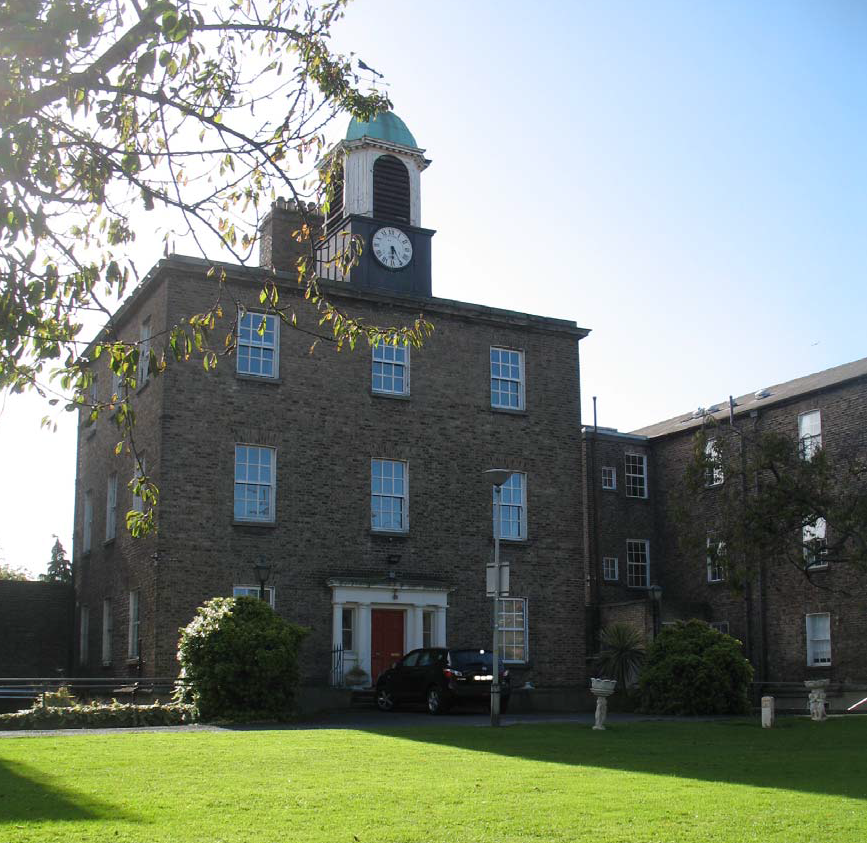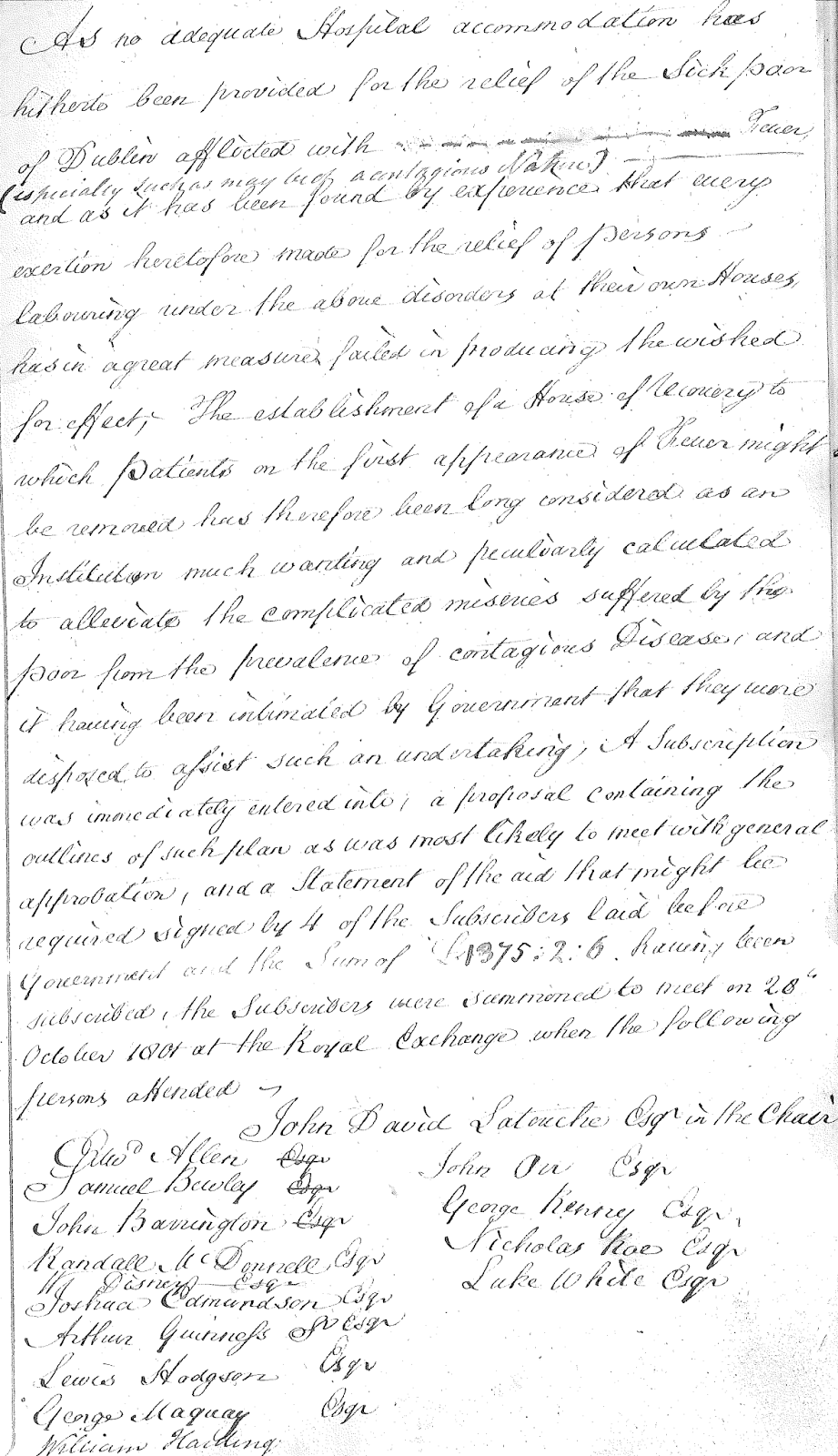Arthur Guinness Jnr, Samuel Bewley, John David La Touche and the Establishment of Cork Street Fever Hospital
The earliest minute book of the Cork Street Fever Hospital
archive, which records meetings from 23 October 1801 to 17 February 1807, is an
excellent source for researching the establishment of the hospital and wider campaign
against the spread of fever in the Dublin Liberties.
 |
Brú Chaoimhin Community Nursing Unit, formerly
The House of Recovery, Cork Street Fever Hospital
(Image taken from |
The minutes of the first two meetings of the provisional
hospital Committee, which came together on 28 October 1801 and 30 October 1801 at the Royal Exchange Buildings, Dublin [now City Hall],
show that those present had a clear idea of the nature and scale of health
problems in a city where fever had been raging since 1798. The minutes state that as
‘...no adequate Hospital accommodation has
hitherto been provided for the relief of the Sick poor of Dublin afflicted with
fever (especially such as may be of a contagious Nature)...it
has been found by experience that every exertion heretofore made for the relief
of persons labouring under the above disorders at their own Houses has in great
measure failed in producing the wished for effect’.
Committee members
believed that the solution lay in the ‘establishment
of a House of Recovery to which patients on the first appearance of Fever might
be removed’.
 |
Minutes of first meeting of the
provisional hospital Committee,
with signatures of attendees at
the bottom (CSFH/1/1/2)
|
Fifteen men were elected as trustees at the second meeting: Edward Allen, John
Barrington, Samuel Bewley, William Disney, Thomas Disney, Arthur Guinness Jnr, William Harding, Lewis Hodgson, John David La Touche, Randall McDonnell,
George Maquay, John Leland Maquay, John Orr, George Renny, and Luke White. Some of these men came from families which are renowned today, notably Arthur Guinness Jnr, who served as an active trustee for 22 years. Arthur was a brewer and a Director of the Bank of Ireland, and was the son of the older Arthur Guinness, the pioneer of Ireland’s most famous alcoholic beverage. Samuel Bewley, tea and
silk merchant; and John David La Touche, the first Governor of the Bank of
Ireland, also came from families that are well-known today. The group was drawn from Anglican and Quaker congregations, and its
members were involved in a wide range of philanthropic activities.
The
aims and motivations of the group in seeking to establish a House of Recovery
were shown at the first meeting, where those present adopted a number of resolutions.
They agreed that ‘manifest poverty and
disease properly ascertained should be the only circumstances necessary to
entitle a Patient to admission’. Committee members also resolved that
admissions of patients be limited to ‘that
part of the City of Dublin called the Liberty’, and declared that ‘the Erection of a new Building adapted in
its construction and all its arrangements for the specific purpose of a House
of Recovery is highly desirable’. A knowledge of the link between the
spread of disease and the living conditions of the poor was reflected in a
resolution which noted the need to prevent ‘the
spreading of contagion in the Houses and Neighbourhood from whence the Patients
shall have been removed, and for the introduction of such habits of Cleanliness,
as may diminish if not destroy the operation of those Causes that have contributed to make such an Institution so
necessary at the present time’.
In
the subsequent weeks and months the Committee worked hard to achieve the aim of
establishing a fever hospital, meeting twenty times between 30 October 1801 and
15 February 1802. Discussion at these meetings was dominated by the need to
secure a plot of ground for the new institution in the area of the Liberties.
After a proposed purchase of land from Robert Mercer fell through, the
Committee resolved on 15 February 1802 to conclude an agreement for an orchard
south of Cork Street held by Anne Donnelly in a lease from Alexander Ross.
Plans
to erect the hospital on the three-acre site proceeded quickly. On 24 April
1802 the Earl of Hardwicke, Lord Lieutenant of Ireland, laid the first stone.
Just over two years later, on 14 May 1804, the first batch of female patients
were admitted. The fever hospital consisted of two buildings: one for the sick,
the other for convalescents. The final cost was calculated at £11,350 14s 6d,
the equivalent of approximately £750,000 today.
Subsequent
minute books demonstrate the struggles of a Committee charged with running a
rapidly expanding institution. The contents of this earliest minute book,
however, show the determination and swift action of those earliest Committee
members, who succeeded in establishing a voluntary hospital within a period of
less than three years in one of Dublin’s most impoverished districts.
Fergus Brady,
Project Archivist